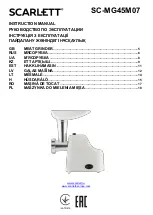
39
EnGLIsh
• Make sure the disc or wheel rotates in the direction of
the arrows on the accessory and the tool.
• Avoid overloading. Should the tool become hot, let it
run a few minutes under no load condition to cool the
accessory. Do not touch accessories before they have
cooled. The discs become very hot during use.
• Never work with the grinding cup without a suitable
protection guard in place.
• Do not use the power tool with a cut-off stand.
• Never use blotters together with bonded
abrasive products.
• Be aware, the wheel continues to rotate after the tools
is switched off.
Proper Hand Position (Fig. G)
WARNING:
To reduce the risk of serious personal injury,
ALWAYS
use proper hand position as shown.
WARNING:
To reduce the risk of serious personal
injury,
ALWAYS
hold securely in anticipation of a
sudden reaction.
Proper hand position requires one hand on the side handle
3
,
with the other hand on the body of the tool, as shown in
Figure G.
Trigger Switch and Lock-off Lever (Fig. A)
WARNING:
Before using the tool, check that the handle is
tightened securely.
1. To turn the tool on, push the lock-off lever
8
toward the
back of the tool, then depress the trigger switch
7
. The tool
will run while the switch is depressed.
2. Turn the tool off by releasing the trigger switch.
WARNING:
Hold the side handle and body of the tool
firmly to maintain control of the tool at start up and
during use and until the wheel or accessory stops rotating.
Make sure the wheel has come to a complete stop be fore
laying the tool down.
WARNING:
Allow the tool to reach full speed before
touching tool to the work surface. Lift the tool from the
work surface before turning the tool off.
Spindle Lock (Fig. B)
The spindle lock
1
is provided to prevent the spindle from
rotating when installing or removing wheels. Operate the
spindle lock only when the tool is turned off, unplugged from
the power supply, and has come to a complete stop.
NOTICE:
To reduce the risk of damage to the tool, do
not engage the spindle lock while the tool is operating.
Damage to the tool will result and attached accessory
may spin off possibly resulting in injury.
To engage the lock, depress the spindle lock button and rotate
the spindle until you are unable to rotate the spindle further.
Surface Grinding, Sanding and Wire
Brushing
CAUTION: Always use the correct guard per the
instructions in this manual.
WARNING: Metal dust build-up.
Extensive use of flap
discs in metal applications can result in the increased
potential for electric shock. To reduce this risk, insert an
RCD before use and clean the ventilation slots daily by
blowing dry compressed air into the ventilation slots
inaccordance with the below maintenance instructions.
To perform work on a the surface of a workpiece:
1. Allow the tool to reach full speed before touching the tool
to the work surface.
2. Apply minimum pressure to the work surface, allowing
the tool to operate at high speed. Material removal rate is
greatest when the tool operates at high speed.
Angle
3. Maintain an appropriate angle between the tool and work
surface. Refer to the chart according to particular function.
Function
Angle
Grinding
20˚-30˚
Sanding with Flap Disc
5˚-10˚
Sanding with Backing Pad
5˚-15˚
Wire Brushing
5˚-10˚
4. Maintain contact between the edge of the wheel and the
work surface.
-
If grinding, sanding with flap discs or wire brushing
move the tool continuously in a forward and back
motion to avoid creating gouges in the work surface.
-
If sanding with a backing pad, move the tool constantly
in a straight line to prevent burning and swirling of
work surface.
nOTE:
Allowing the tool to rest on the work surface without
moving will damage the work piece.
5. Remove the tool from work surface before turning tool off.
Allow the tool to stop rotating before laying it down.
CAUTION:
Use extra care when working over an edge, as
a sudden sharp movement of grinder may be experienced.
Precautions To Take When Working on a
Painted Workpiece
1. Sanding or wire brushing of lead based paint is NOT
RECOMMENDED due to the difficulty of controlling the
contaminated dust. The greatest danger of lead poisoning is
to children and pregnant women.
















































